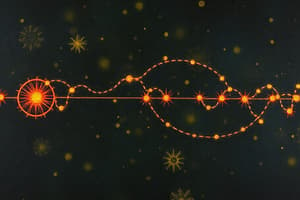Podcast
Questions and Answers
Which molecules are energy-rich and involved in oxidative phosphorylation?
Which molecules are energy-rich and involved in oxidative phosphorylation?
- NADH and FADH2 (correct)
- Acetyl coenzyme A
- Pyruvate
- NAD+ and FAD
What is the process called when ATP is made using the proton gradient generated by the electron transport chain?
What is the process called when ATP is made using the proton gradient generated by the electron transport chain?
- Substrate level phosphorylation
- Chemiosmosis (correct)
- Citric acid cycle
- Glycolysis
What is the role of NADH and FADH2 in cellular respiration?
What is the role of NADH and FADH2 in cellular respiration?
- They generate carbon dioxide
- They convert glucose into pyruvate
- They deliver electrons to the electron transport chain (correct)
- They produce ATP directly
Where does oxidative phosphorylation occur in the cell?
Where does oxidative phosphorylation occur in the cell?
What is the main function of the electron transport chain?
What is the main function of the electron transport chain?
What molecules do NADH and FADH2 turn back into during the delivery of electrons in cellular respiration?
What molecules do NADH and FADH2 turn back into during the delivery of electrons in cellular respiration?
Which of the following is the terminal electron acceptor in the electron transport pathway?
Which of the following is the terminal electron acceptor in the electron transport pathway?
Which complex in the electron transport chain transfers electrons from FADH2 to Coenzyme Q?
Which complex in the electron transport chain transfers electrons from FADH2 to Coenzyme Q?
What is the function of ATP synthase in oxidative phosphorylation?
What is the function of ATP synthase in oxidative phosphorylation?
What is the role of Coenzyme Q in electron transport?
What is the role of Coenzyme Q in electron transport?
What powers the ATP synthase in oxidative phosphorylation?
What powers the ATP synthase in oxidative phosphorylation?
Which of the following conditions favors increased activity of the electron transport chain and oxidative phosphorylation?
Which of the following conditions favors increased activity of the electron transport chain and oxidative phosphorylation?
Which of the following would be the effect of cyanide poisoning on the electron transport chain and the proton gradient across the inner mitochondrial membrane?
Which of the following would be the effect of cyanide poisoning on the electron transport chain and the proton gradient across the inner mitochondrial membrane?
How would DNP affect the amount of ATP produced in cellular respiration?
How would DNP affect the amount of ATP produced in cellular respiration?
Which metabolic change would be expected in a patient exposed to a toxic compound that increases the permeability of mitochondrial membranes to protons?
Which metabolic change would be expected in a patient exposed to a toxic compound that increases the permeability of mitochondrial membranes to protons?
What effect does cyanide poisoning have on the electron transport chain?
What effect does cyanide poisoning have on the electron transport chain?
What effect does DNP have on the inner mitochondrial membrane?
What effect does DNP have on the inner mitochondrial membrane?
Why is DNP no longer on the market as a weight-loss drug?
Why is DNP no longer on the market as a weight-loss drug?
Which of the following is true about glucose degradation under aerobic conditions?
Which of the following is true about glucose degradation under aerobic conditions?
Which of the following happens when ADP levels rise and the demand for ATP synthesis increases?
Which of the following happens when ADP levels rise and the demand for ATP synthesis increases?
What is the effect of cyanide on ATP production during respiration?
What is the effect of cyanide on ATP production during respiration?
What is the net movement of a negative charge when ATP is transported out of the mitochondria?
What is the net movement of a negative charge when ATP is transported out of the mitochondria?
What is the P/O (Phosphate/Oxygen) Ratio in the electron transport chain?
What is the P/O (Phosphate/Oxygen) Ratio in the electron transport chain?
Which shuttle system is commonly encountered in glycolysis?
Which shuttle system is commonly encountered in glycolysis?
Which shuttle system employs an intermediate of glycolysis rather than the TCA cycle?
Which shuttle system employs an intermediate of glycolysis rather than the TCA cycle?
Which of the following directly provides the energy needed to form ATP in the mitochondrion?
Which of the following directly provides the energy needed to form ATP in the mitochondrion?
During electron transport, protons are pumped out of the mitochondrion at each of the major sites except for:
During electron transport, protons are pumped out of the mitochondrion at each of the major sites except for:
Human produce a natural uncoupling protein that can uncouple the proton gradient from ATP synthesis. Under which of the following conditions, you think that body produces this protein?
Human produce a natural uncoupling protein that can uncouple the proton gradient from ATP synthesis. Under which of the following conditions, you think that body produces this protein?
Which of the following drugs would be most likely to prevent cavities caused by S. mutans?
Which of the following drugs would be most likely to prevent cavities caused by S. mutans?
The enzyme isocitrate dehydrogenase (IDH) catalyzes the conversion of isocitrate to α-ketoglutarate (step 3). IDH is allosterically activated by ADP at high concentrations. Which of the following best describes how this interaction helps regulate the Krebs cycle?
The enzyme isocitrate dehydrogenase (IDH) catalyzes the conversion of isocitrate to α-ketoglutarate (step 3). IDH is allosterically activated by ADP at high concentrations. Which of the following best describes how this interaction helps regulate the Krebs cycle?
Flashcards are hidden until you start studying




